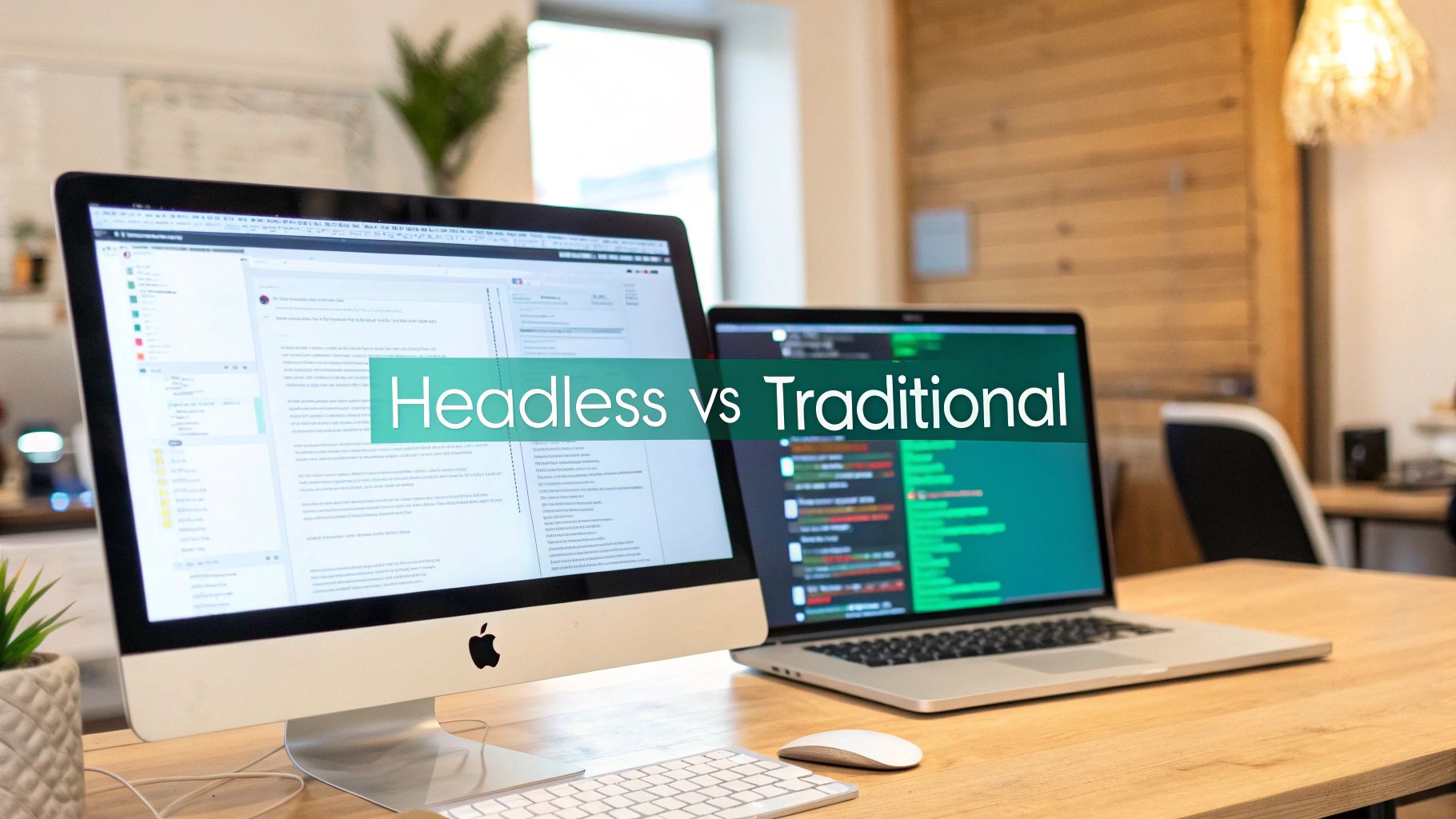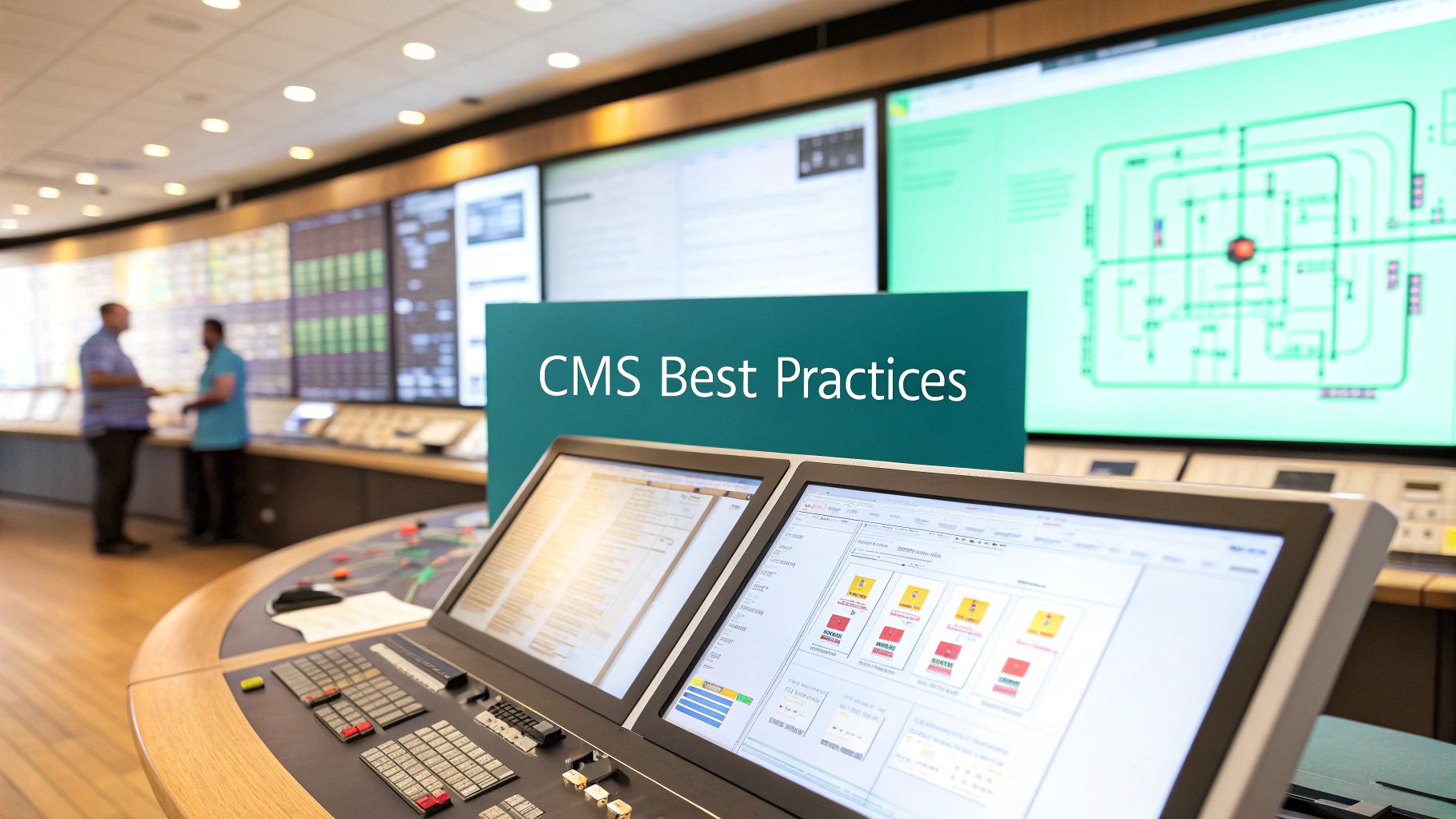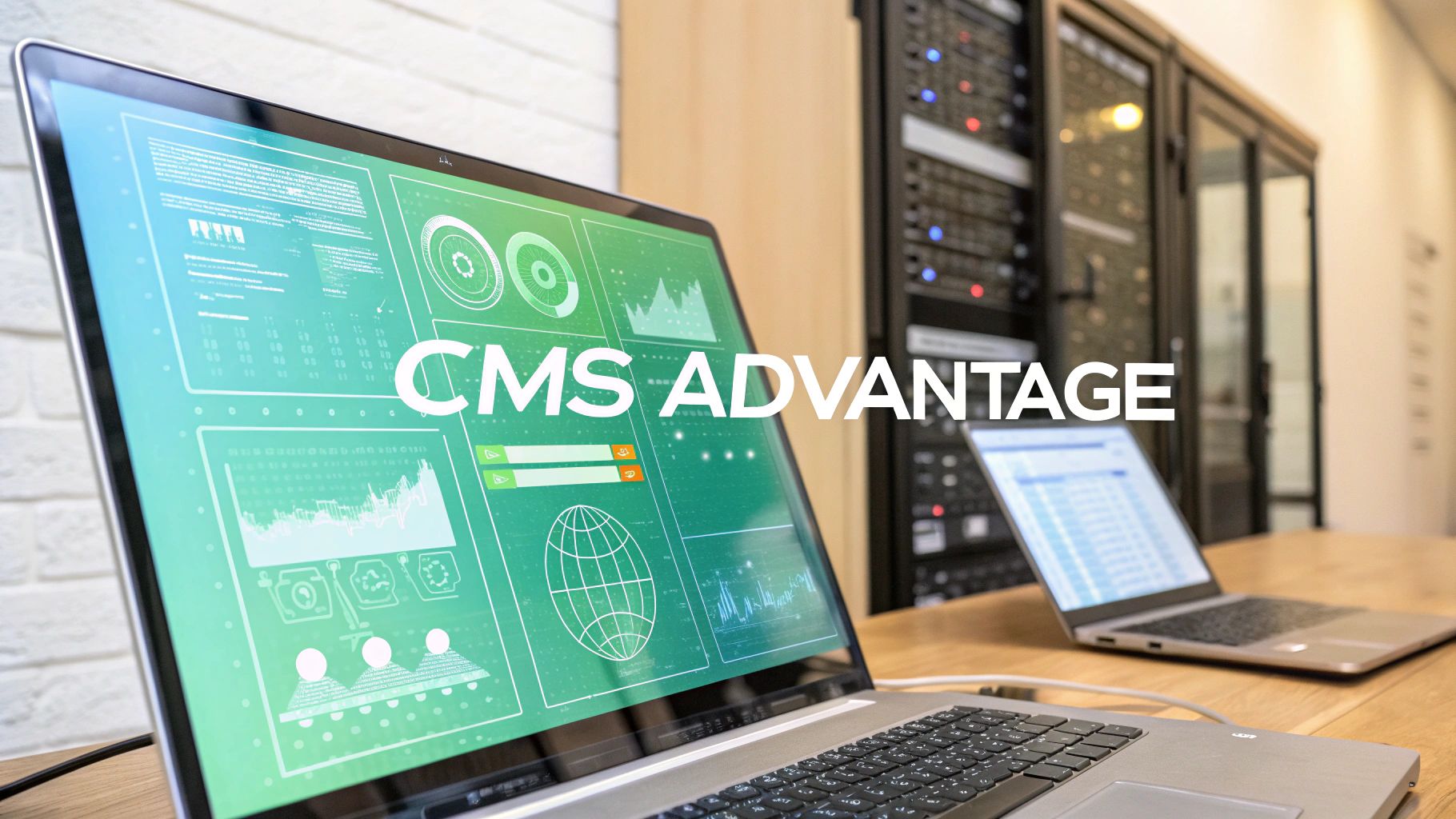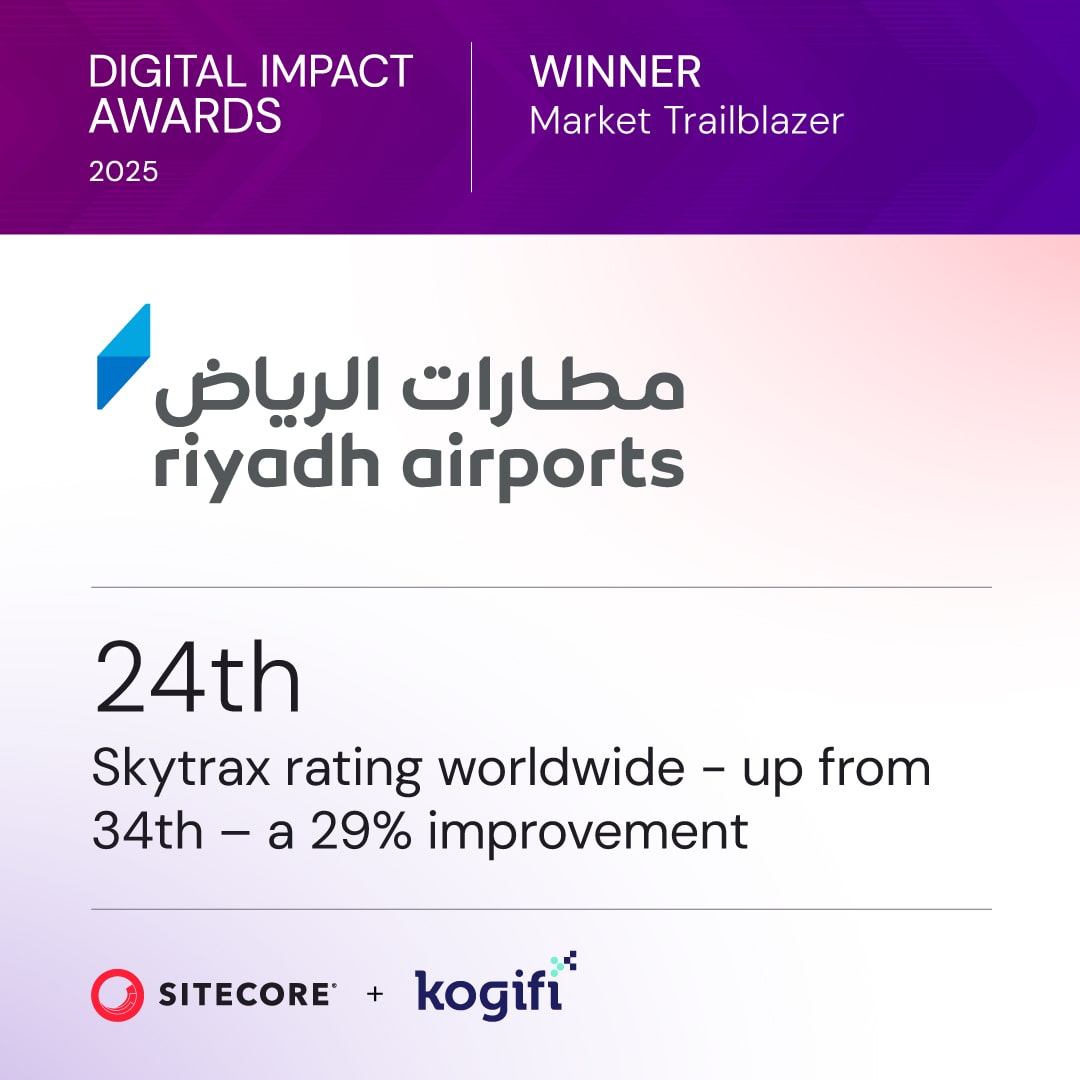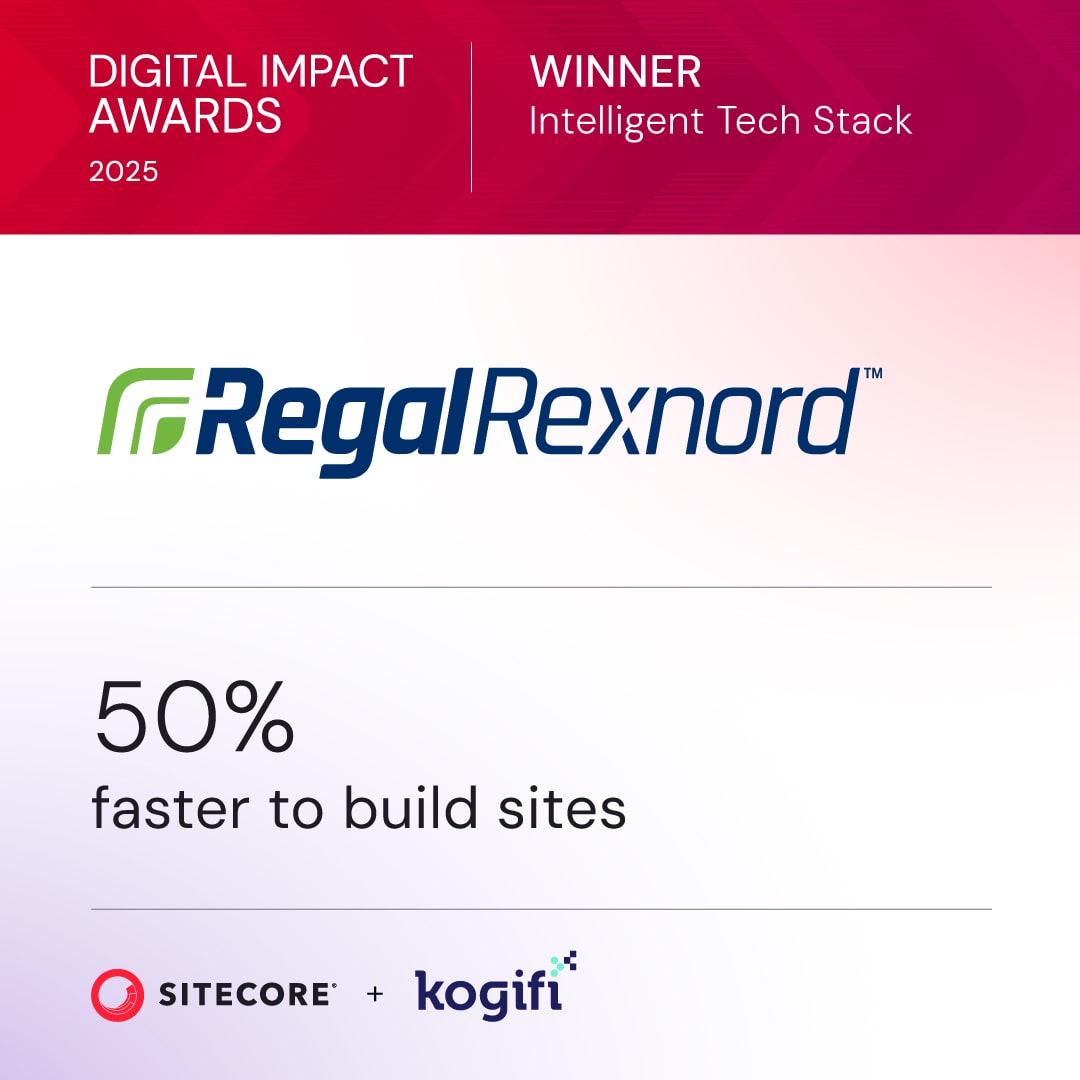The biggest difference between a headless CMS and a traditional CMS boils down to one thing: architecture. A traditional CMS locks content management and presentation together, while a headless CMS separates them.
Think of it this way: a traditional system like classic SharePoint controls both your content and exactly how it looks on a website. In contrast, a headless platform like Sitecore XM Cloud just manages the content, which can then be sent via an API to any front end you can dream of—a website, a mobile app, or even a smart device.
Understanding Headless vs Traditional CMS Architectures
To pick the right platform, you have to get this core distinction. A traditional CMS is a monolith. Classic SharePoint environments are a perfect example, where the content database, the business rules, and the front-end display are all fused into one big, interdependent system. This all-in-one approach dictates exactly how and where your content shows up, which is usually just a standard webpage.
A headless CMS, on the other hand, breaks these layers apart. The back-end ‘body’—where you store and manage content—operates on its own. An API (Application Programming Interface) then acts as a messenger, delivering that raw, unformatted content to any front-end ‘head’ you want to build. This API-first method is the real engine behind modern omnichannel strategies.
Sitecore’s own journey shows this industry shift perfectly. The move from a traditional, coupled architecture in its older XP versions to the pioneering headless model with Sitecore XM Cloud is a great example. This modern approach gives you true content portability, which is essential for building a flexible digital presence. You can learn more about this modern structure in our guide on future-proofing with composable DXP architecture.
Ultimately, this flexibility frees up your development teams to use the tech they love and lets marketers create content once and publish it absolutely everywhere.
At a Glance Comparing Headless and Traditional CMS
To make the differences even clearer, this table contrasts the core attributes of headless and traditional CMS platforms. It’s a quick summary that highlights the key distinctions in architecture, developer freedom, and where each one shines.
As you can see, the choice isn't just about features—it's about fundamentally different ways of building and delivering digital experiences.
Exploring the All-in-One Traditional CMS Model
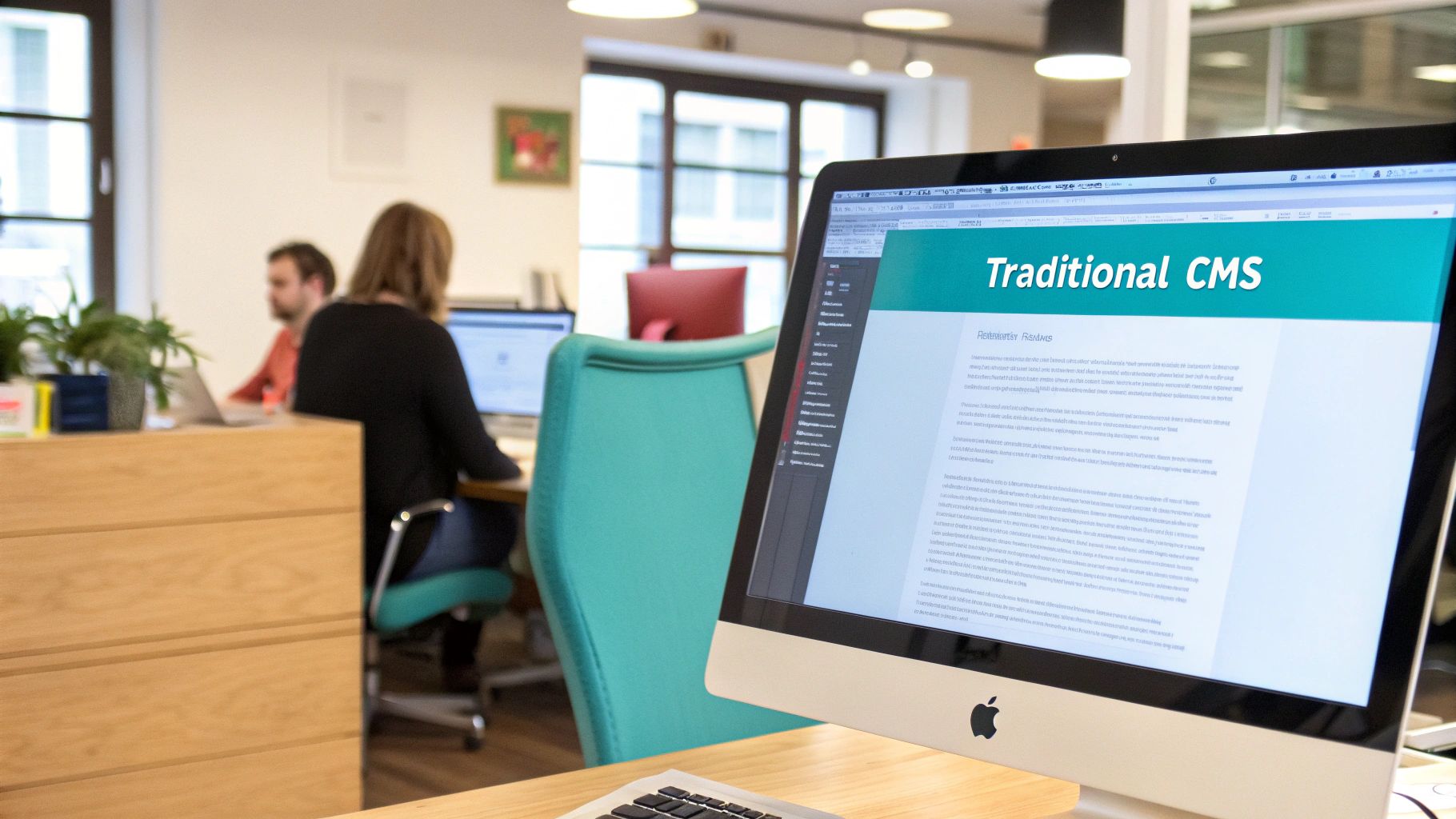
For decades, the traditional, all-in-one CMS has been the workhorse of the web. It's a straightforward, integrated approach where the back end (where you create and manage content) and the front end (how that content looks) are bundled into a single system. This tight coupling creates a predictable and self-contained environment for content teams.
Platforms like SharePoint Server and earlier versions of Sitecore XP are classic examples. They give you a complete toolkit where content and presentation are deeply connected. Everything—from writing copy and managing media to designing templates and publishing pages—happens inside one platform, which simplifies the entire workflow.
This monolithic structure is actually a major advantage in certain situations. If your organization needs to quickly launch templated websites or manage an internal corporate portal, a traditional CMS excels. Its out-of-the-box features and familiar interfaces empower non-technical users, especially marketers, to manage content without needing constant help from developers.
The Appeal of a Unified Authoring Experience
One of the biggest draws of a traditional CMS is its what-you-see-is-what-you-get (WYSIWYG) editor. Because the system controls both content and presentation, it delivers an intuitive, in-context editing experience. Marketers can build pages, arrange components, and see a real-time preview of exactly how their content will look to visitors.
This direct control makes day-to-day content tasks much simpler. For instance, in a classic SharePoint setup, a user can create a new page for an internal announcement, add text, drop in an image, and publish it using pre-defined templates—all without leaving the interface. The workflow is linear and the result is predictable.
A key benefit of the traditional model is its ability to reduce dependency on development teams for routine content updates. Marketers can operate with greater autonomy within established templates, accelerating the pace of simple content publishing for a single channel like a website.
But this simplicity comes at a cost. The same tight coupling that makes these systems so user-friendly also makes them rigid.
Inherent Constraints and Development Rigidity
The main drawback of a traditional CMS is its lack of flexibility. Frontend development is often locked into the platform’s proprietary templating engine and specific programming languages. For example, developers on older Sitecore XP versions were often stuck with .NET for building presentation components, which limited their ability to use modern JavaScript frameworks like React or Vue.js.
This rigidity creates some serious hurdles in a multi-channel world.
- Multichannel Content Delivery: Pushing content to anything other than a standard website—like a mobile app, digital kiosk, or smartwatch—is a real challenge. The content is often tangled up with presentational code, making it difficult to extract and repurpose for other "heads."
- Monolithic Updates: Upgrades and maintenance impact the entire system. A simple front-end design tweak might require a full deployment of the entire application, which increases risk and slows down innovation.
- Scalability Issues: Scaling a monolithic application can be inefficient. You have to scale the entire stack at once, even if only one component is seeing heavy traffic. This often leads to higher infrastructure costs.
Understanding these limitations is crucial, as they are the very reason more agile, decoupled architectures emerged. For businesses focused on digital agility and omnichannel reach, these constraints are often the catalyst for exploring headless alternatives. To get a better sense of the available options, check out our guide on the best enterprise content management systems and see how modern platforms are tackling these challenges.
Embracing Agility with a Headless CMS
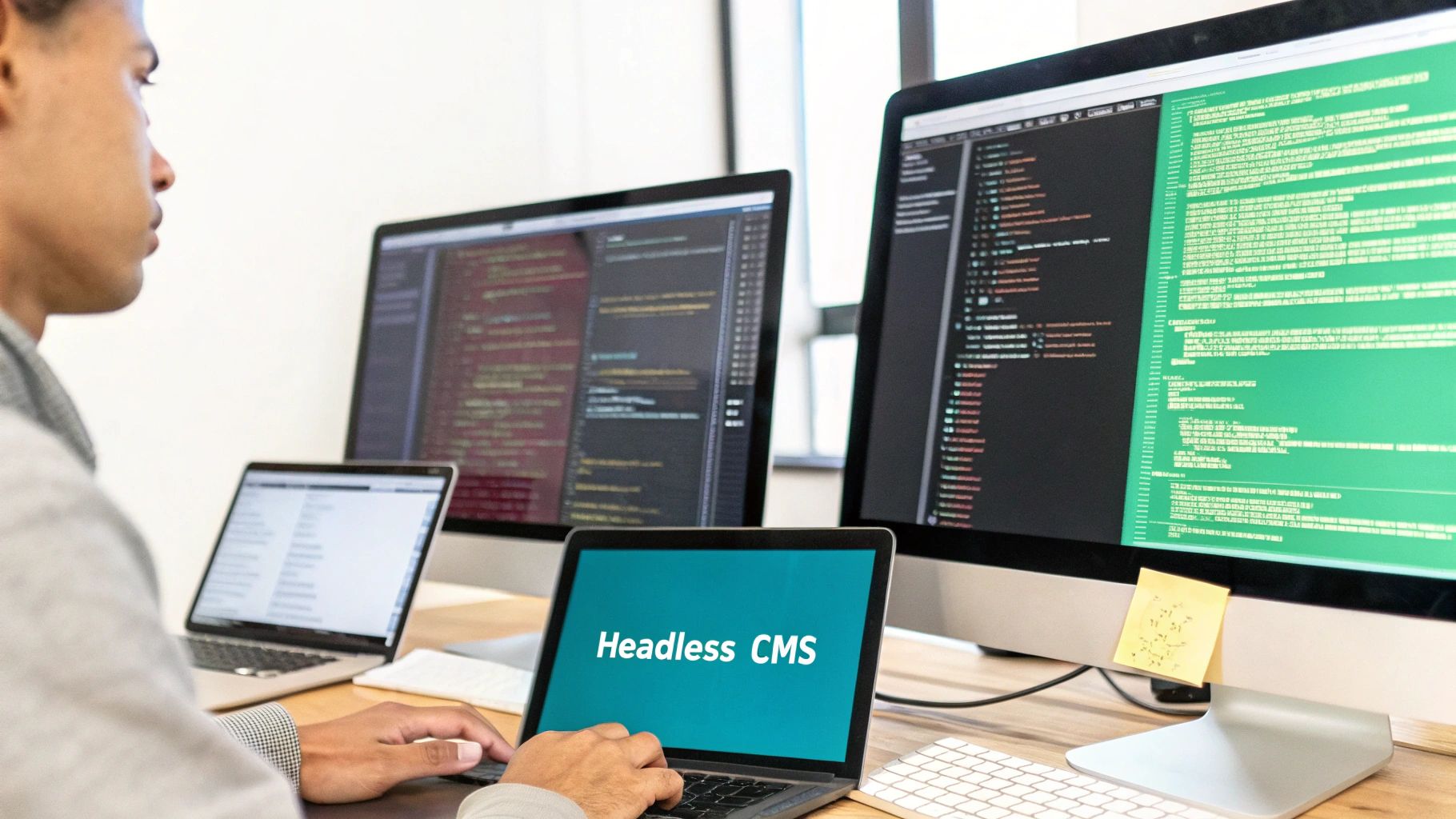
The headless CMS isn't just a new trend; it’s a direct answer to the reality of modern customer journeys, which now span dozens of touchpoints. Its API-first approach was built for a world where content needs to flow effortlessly to websites, mobile apps, digital kiosks, and even smart devices. The architecture gets its power by decoupling the content repository (the "body") from the presentation layer (the "head"), unlocking a whole new level of speed and flexibility.
At its core, this separation of concerns is a win-win for developers and marketers. Developers are no longer locked into a monolithic system's proprietary tools. Instead, they’re free to use their favorite frontend frameworks—like React, Vue, or Angular—to build faster, more engaging digital experiences that look incredible.
For marketers, this unlocks the holy grail: a "create once, publish everywhere" strategy. A single piece of structured content can be written in the CMS and then pushed to any channel you can think of, without needing a developer to rebuild it each time. This approach keeps your brand message perfectly consistent everywhere a customer interacts with it, from a desktop browser to a voice-activated assistant.
Driving Business Value with Decoupled Architecture
The business reasons for shifting to headless are clear and compelling. In today's market, speed is everything. A decoupled architecture allows your teams to work in parallel—frontend developers can build and iterate on the user interface while content authors are simultaneously creating content in the back end. This concurrent workflow shaves a massive amount of time off development cycles.
This trend is playing out in the market’s explosive growth. The global headless CMS market is expanding at a remarkable pace, fueled by the demand for omnichannel content and greater developer freedom. Forecasts project the headless CMS software market will surge from USD 973.8 million in 2025 to USD 7,113.6 million by 2035, reflecting a powerful compound annual growth rate of 22.6%. You can dig deeper into these projections in this comprehensive headless CMS software market report.
The fundamental advantage of a headless CMS is its ability to treat content as a structured, reusable asset. By detaching it from a specific presentation, you transform it from a static page element into a dynamic resource ready for any future channel.
This architectural agility is no longer a nice-to-have; it's essential for crafting the consistent, personalized experiences that customers now expect across a fragmented digital ecosystem.
Sitecore XM Cloud: The Apex of Headless Innovation
Sitecore has been a major player in this evolution, and its current offerings perfectly demonstrate the power of the headless model. Sitecore XM Cloud is a fantastic example of a modern, SaaS-based headless CMS built for the demands of the enterprise. It combines the powerful content management capabilities Sitecore is famous for with the raw speed and flexibility of a decoupled architecture.
With XM Cloud, developers can use tools like the Sitecore JavaScript Rendering SDKs (JSS) to build high-performance frontends with whatever framework they prefer. This makes it possible to create exceptional user experiences that are not only blazingly fast but also deeply connected to Sitecore’s personalization and analytics engines. For a technical walkthrough, our guide offers practical steps on implementing a headless site with JSS in XM Cloud.
This separation brings some serious advantages to the table:
- Frontend Freedom: Developers can innovate with modern tech stacks without being tethered to a .NET-centric backend.
- Enhanced Performance: Unlocks static site generation and edge delivery, leading to lightning-fast page loads and better Core Web Vitals.
- Scalability on Demand: As a cloud-native platform, XM Cloud scales automatically to handle traffic spikes without anyone lifting a finger.
Ultimately, embracing a headless CMS like Sitecore XM Cloud is a strategic decision. It’s not just about adopting a new piece of tech—it's about re-architecting your entire digital strategy for agility, performance, and whatever comes next.
Comparing Critical Differences for Your Business
Choosing between a headless and traditional CMS isn't just a technical decision—it's a business one. Your choice will ripple through your entire organization, affecting everything from how fast your developers can build to how agile your marketers can be. It shapes your site's performance, your long-term costs, and ultimately, your ability to compete. This is where you see the real-world gap between composable platforms like Sitecore XM Cloud and legacy systems like SharePoint.
The data backs this up. A headless CMS often gives businesses a clear edge. Industry analyses show that businesses adopting headless architectures often see a faster time-to-market, improved site performance, and more effective personalization. For instance, some studies indicate a significant boost in developer productivity and faster page load times, which are crucial metrics for success. You can find general insights on CMS performance statistics and insights on storyblok.com.
This infographic gives a great high-level look at the key differences in speed, flexibility, and complexity.
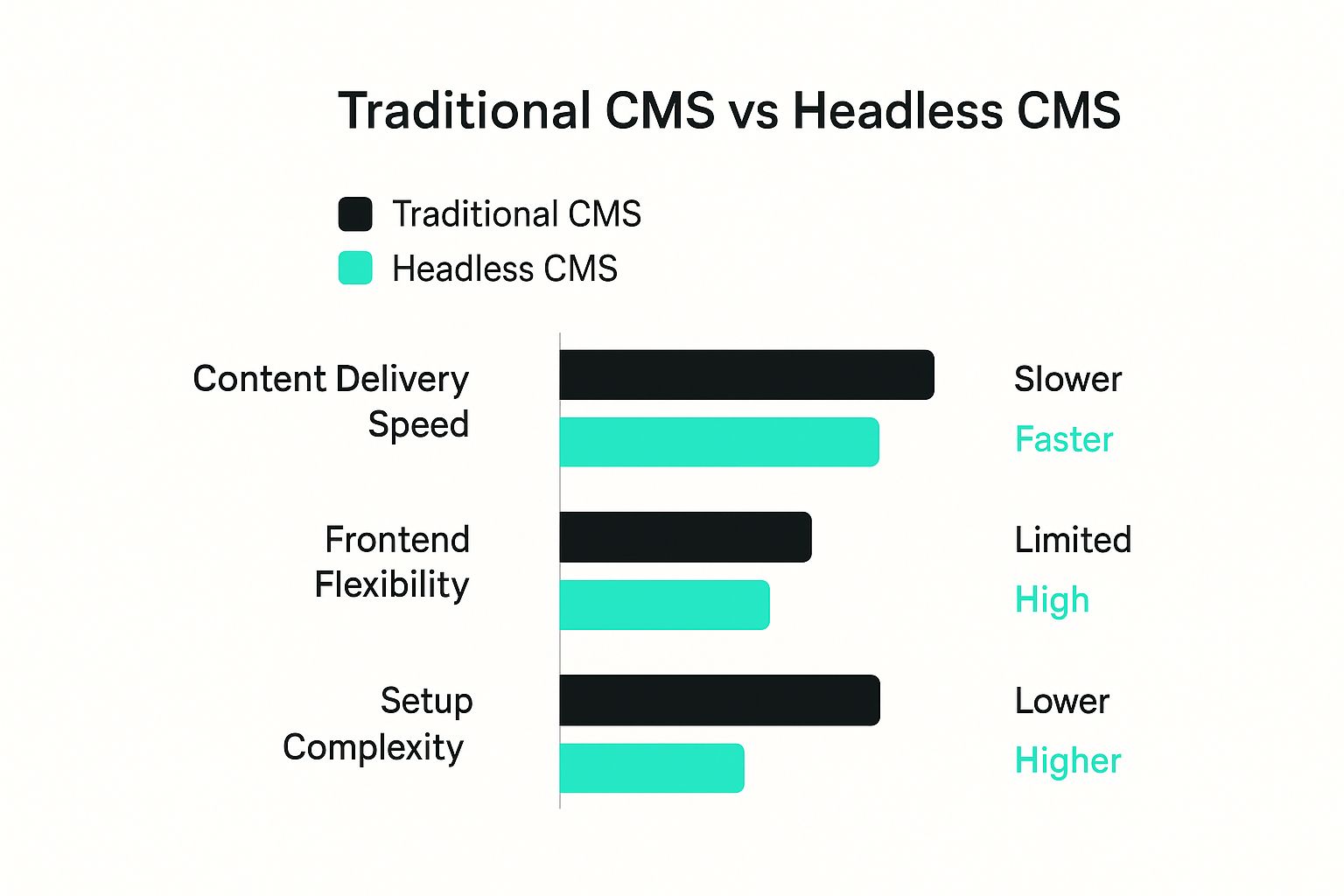
As you can see, a traditional CMS might seem simpler to set up initially, but a headless system quickly pulls ahead with its superior performance and flexibility.
Let's break down how these differences play out for your key teams and business functions. The following table provides a side-by-side look at the real impact of each architecture.
Business Impact Analysis: Headless vs. Traditional
This comparison highlights that while a traditional CMS offers a contained, all-in-one solution, a headless CMS provides the flexibility and performance needed to adapt and grow in a fast-moving digital world.
Developer Experience and Innovation
In a classic monolithic system—think older Sitecore XP versions or a SharePoint Server—developers are often stuck working inside a box. They’re limited to the platform’s specific templating engine and programming languages, which can kill creativity and make it tough to hire skilled developers who want to work with modern tools. This friction slows everything down.
A headless approach completely flips the script. By separating the content backend from the presentation layer, developers are free to use whatever tech they love, whether it's React, Vue, or Angular. This API-first model leads to faster builds, cleaner code, and the ability to craft incredibly fast, optimized user experiences.
The core difference in developer experience is freedom. A headless architecture empowers developers to build with the best tools for the job, rather than the tools dictated by the CMS, leading to faster innovation and a more resilient tech stack.
Marketer Agility and Omnichannel Reach
For marketers, the difference is just as dramatic. With a traditional CMS, content is often welded to a specific page template. Want to use that same campaign message on the website, a mobile app, and a digital kiosk? You’ll likely have to create and manage three separate versions—a recipe for wasted time and inconsistencies.
A headless CMS, on the other hand, is built for an omnichannel world. Marketers create structured, reusable content that isn't tied to any particular design. A single "product update" can be authored once in the content hub and then pushed via API to any channel imaginable. This "create once, publish everywhere" model is essential for maintaining brand consistency and efficiency as customer touchpoints multiply.
Performance and Scalability
Performance is where headless truly shines. Monolithic platforms often host the content management backend and the public-facing website on the same infrastructure. When traffic spikes, everything can grind to a halt, affecting not just your customers but your content team trying to make updates.
Headless architectures solve this problem by design. Since the content delivery "head" is separate, it can be built with modern tech and deployed on a global Content Delivery Network (CDN). This is exactly how Sitecore XM Cloud works, resulting in lightning-fast load times and excellent Core Web Vitals. Scaling is also far more efficient, as you can scale the frontend and backend independently to meet demand, ensuring your site stays fast and reliable even under heavy traffic.
Making the Right Choice for Your Digital Strategy
Picking between a headless and a traditional CMS is one of those critical moments that will define your digital strategy for years to come. It’s not about which one is "better" in a vacuum; it’s about finding the architecture that truly aligns with your business goals, your team's technical skills, and your long-term ambitions.
A traditional CMS like SharePoint is still a perfectly practical and effective choice in the right setting. It shines in environments where simplicity and predictability are the name of the game.
- Internal-Facing Applications: For company intranets, knowledge bases, or document portals, SharePoint is a secure, out-of-the-box solution that non-technical users can manage without a steep learning curve.
- Simple Corporate Websites: If all you need is a standard, template-driven marketing site with straightforward content, a traditional CMS gets you to launch much faster.
- Teams with Minimal Development Resources: Organizations without a dedicated frontend development team really benefit from the all-in-one nature of a coupled system, sidestepping the complexities of building and maintaining API integrations.
In these situations, the built-in authoring experience and predefined templates aren't limitations—they're assets. They provide a clear, reliable framework that makes publishing content to a single, well-defined channel incredibly efficient.
When Headless Becomes Essential
But the second your strategy needs to reach beyond a single website, the conversation pivots entirely toward headless. For any organization serious about delivering consistent, high-performance, and innovative experiences across multiple channels, a headless CMS is the only real path forward. This is where a platform like Sitecore XM Cloud truly comes into its own.
Sitecore's headless offerings are built specifically for the complexities of modern digital ecosystems. They give you the foundation for a truly composable Digital Experience Platform (DXP), where you can plug in best-of-breed tools for personalization, e-commerce, and analytics without being handcuffed to a monolithic suite.
The decision to go headless is less about replacing an old system and more about adopting a new mindset. It's a commitment to treating content as a portable, structured asset that can power any customer touchpoint, now and in the future.
This mindset is non-negotiable for businesses trying to create a seamless customer journey that flows effortlessly between web, mobile, and whatever digital interfaces come next.
A Framework for Your Decision
To make the right call, you need to honestly evaluate where your organization is today and—more importantly—where you plan to be in the next three to five years.
Beyond the architecture, remember to follow overarching content management system best practices for long-term success. Choosing the right platform is just step one; how you manage and govern your content will ultimately determine your ROI. A headless architecture from Sitecore doesn't just solve today's problems—it provides the agile, future-ready foundation you need for sustained digital growth.
Modernizing Your Architecture with Sitecore
If you're running on a traditional system, the idea of a complete architectural overhaul can be intimidating. Moving from a monolithic platform—whether it's an older Sitecore XP instance or even a SharePoint environment—to a flexible, composable DXP needs a solid plan. The goal is to embrace Sitecore's headless solutions without attempting a risky, all-at-once "big bang" migration that could bring your operations to a halt.
A phased, strategic approach is always the better route. This method lets you deliver value incrementally while keeping risks in check. And a successful migration doesn't start with technology; it starts with your content.
A Practical Migration Roadmap
The very first step is a deep audit of your existing content and a complete redesign of your content models. In a system like SharePoint, content is usually locked to specific pages. For a headless future, you have to break it free, restructuring it to be channel-agnostic so it becomes a reusable asset for any frontend you can imagine.
From there, the journey breaks down into a few key stages:
- Choose Frontend Technologies: With Sitecore's headless architecture, your developers are no longer boxed in. They can use the Sitecore JavaScript Rendering SDKs (JSS) to build with modern frameworks like React or Vue, which means faster, more engaging user experiences.
- Plan API Integrations: You'll need to map out how your new frontend will talk to Sitecore and other critical business systems. This API-first strategy is the backbone of a truly composable platform.
- Upskill Your Teams: This change affects everyone. Developers have to adapt to a decoupled workflow, and marketers need to learn to think in terms of structured, omnichannel content instead of just web pages.
This strategic shift is happening for a reason. Headless platforms are gaining serious ground, now representing over 20% of the CMS market as of early 2025. This growth is fueled by the API-first approach that modern omnichannel strategies demand. You can dig into more data on CMS market share and emerging platforms on attowp.com.
Incremental Modernization in Action
Sitecore’s composable architecture is tailor-made for this kind of step-by-step modernization. You don't have to rip and replace everything at once. A common starting point is to decouple a single, high-value web property. This initial project acts as a proof-of-concept, showing off the performance and agility benefits of headless without touching the rest of your digital ecosystem.
The core principle is to de-risk the transition by breaking it into manageable pieces. Start by decoupling a single website, then integrate a best-of-breed tool like Sitecore Personalize, and continue adding capabilities as you prove their value.
Once that first website is successfully running headless, you can progressively bring in other tools from the Sitecore DXP suite or third-party vendors. If you're looking for parallels, the principles behind a monolith to microservices migration offer valuable insights for content management. Each step builds on the last, gradually transforming your monolithic setup into a flexible, powerful DXP. This measured approach ensures you’re delivering real business value at every stage of the journey.
Common Questions
When you're weighing a headless CMS against a traditional one, a few practical questions always come up. Here’s a look at how modern platforms tackle these common concerns.
Can Marketers Still Preview Content in a Headless CMS?
Absolutely. A common myth is that going headless means giving up visual control, but that's just not the case anymore.
Modern platforms like Sitecore XM Cloud come with sophisticated visual authoring tools. Marketers can use features like Sitecore Pages to edit content right on the page, seeing exactly how changes will look on any frontend without being stuck in a monolithic system. It’s the best of both worlds—you get the familiar WYSIWYG experience from platforms like SharePoint while the backend stays flexible.
Is a Headless CMS More Expensive?
It might seem like it at first, but the total cost of ownership is often lower with a headless CMS.
While the initial setup might require some specialized development, the long-term savings really add up. You're spending less on maintaining a bulky, all-in-one stack and your development cycles get a lot faster. Plus, the ability to reuse content across multiple channels gives your ROI a serious boost. With Sitecore’s composable model, you only pay for the capabilities you actually need, sidestepping the bundled costs of traditional platforms.
Do I Have to Migrate Everything at Once?
Not at all. In fact, a phased migration is the way to go.
You can start by decoupling just one piece of your digital presence—like your main website—while your other properties stay put on the old system. This incremental strategy, which is fully supported by Sitecore's architecture, lets you manage risk, prove value, and modernize at a pace that makes sense for your business.
Ready to modernize your digital architecture with a leading Sitecore partner? Kogifi has the expertise to guide your transition from a traditional setup to a flexible, high-performance DXP. Learn more about our solutions.

















